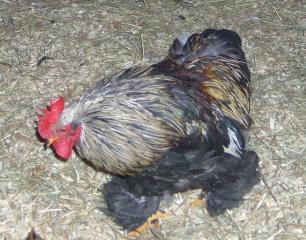Quote:
I am interested in the mille fluer pattern but do not have the room to do experimental crosses.
How to make mille from scratch
1. Cross a buff columbian male with black, mottled females = F1 Black female birds with red in hackles and breast. Males will be black leaking red in the pyle zone or black leaking silver in the pyle zone.
2. Cross the F1 offspring- The F2 offspring will vary- Pick the birds with the least amount of black that are mottled. Many of the birds will be dark in color because of the black intensifying genes found in the black mottled females. One in 16 of the birds should be close to what you want. If you are lucky the black mottled parent bird will be columbian restricted and all of the offspring will be columbian restricted.
3. Cross the F2 birds= F3 this cross should produce mille fluer birds. Some may be darker than others.
I think the problems associated with the mille fluer are due to different restrictors and even E locus alleles. There is most likely more than one columbian restrictor and all E locus alleles are not the same. There are different variations of the wild type allele, brown allele and wheaten alleles. An example is the birchen allele, the birchen allele found in the fayoumi is different than the birchen allele found in other birchen birds.
Lots of questions but I do not have the answers.
Tim
I am interested in the mille fluer pattern but do not have the room to do experimental crosses.
How to make mille from scratch
1. Cross a buff columbian male with black, mottled females = F1 Black female birds with red in hackles and breast. Males will be black leaking red in the pyle zone or black leaking silver in the pyle zone.
2. Cross the F1 offspring- The F2 offspring will vary- Pick the birds with the least amount of black that are mottled. Many of the birds will be dark in color because of the black intensifying genes found in the black mottled females. One in 16 of the birds should be close to what you want. If you are lucky the black mottled parent bird will be columbian restricted and all of the offspring will be columbian restricted.
3. Cross the F2 birds= F3 this cross should produce mille fluer birds. Some may be darker than others.
I think the problems associated with the mille fluer are due to different restrictors and even E locus alleles. There is most likely more than one columbian restrictor and all E locus alleles are not the same. There are different variations of the wild type allele, brown allele and wheaten alleles. An example is the birchen allele, the birchen allele found in the fayoumi is different than the birchen allele found in other birchen birds.
Lots of questions but I do not have the answers.
Tim











